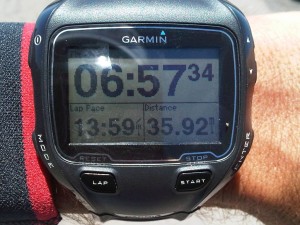Garmin 910XT – Product Review
In January 2010, I wrote a “What I Want” blog post about GPS watches. At the time I was considering buying a GPS watch, but I wasn’t happy with the available options. I was also struggling with the question of whether I wanted a GPS watch at all. I have a tendency to get a little too wrapped up in numbers and was worried that having too much data on my wrist (time, pace, distance, elevation gain, etc.) would detract from my running experience. I liked to think that I just went out and ran for the pure sake of running. Who cares how far or how long or how high? And I’d always done well enough just estimating distance using online services like gmap-pedometer.com or maps (for trail runs) or just guessing based on assumed pace.
But when I was training for the LA Marathon and got the sub-3:00 goal in my mind, I started incorporating tempo and speedwork-type runs into my training. The first few tempo runs I did were total failures. Part of that was fitness, but the other part was that I had no idea how fast I was running. I don’t have anyplace around me with mile markers, so if I wanted to try to run three or four 6:20-ish miles in the middle of a run, I just increased my pace to what I thought might be 6:20/mile. The first few times I tried this, I couldn’t sustain it for more than 10-12 minutes, which wasn’t close to long enough. When I’d map it out after the run, it seemed like I was running way too fast. One day, I was asking Tyler about GPS watches and he offered to loan me his Garmin Forerunner 405. I started using it and by paying attention to my approximate pace, I was able to sustain actual 6:20s for my goal miles. As it turned out, I was definitely doing my tempo miles way too fast. Also, while having the data on my wrist was a little distracting, it’s also really nice. No more guessing! And I found I didn’t become too too crazy about it. I was hooked. After some hemming and hawing, I even wore it for the Marathon (see below). For the first half it was nice to know my mile-splits, not so much for the second half of the race!
The 405 is a nice watch and I’m grateful to Tyler for letting me borrow it, but it’s not the watch I want. The touch-bezel thing doesn’t work all that great, the battery doesn’t last long enough for my ultrarunning and it doesn’t display any elevation data. I started looking into other options – and there are lots of them out there these days. I’ve been happy with my Garmin Edge 500, so Garmin was the default brand, but before deciding I also looked at watches from Suunto and Soleus. In the end, as you might have noticed from some of the photos in my recent post about my run to the summit of Haleakala, I bought a Garmin Forerunner 910XT.
I had a gift certificate to TriVillage (thanks Maptote!) and they were having a sale with 15% off purchases over $200 (sale still going on, I think – when you put an item in your cart, there’s a box with the code – order200-15 – on that page).
And so far, I’m really happy with the purchase. All that “purity of the run” stuff I was worried about maintaining by not having speed, distance and elevation data on my wrist. I came to realize that it’s sorta nonsense. If I don’t have the data on my wrist, I think about it while I’m running and look it up when I get home anyway. And I can always go for a run without the watch!
The 910XT is not the perfect watch I described in my “What I Want” blog post, but really, what is “perfect”? There are lots of technical, details reviews of the 910XT online (DC Rainmaker is pretty much the best), but here are my quick thoughts.
Here’s what I like about the 910xt:
- Battery life – claimed to be 20 hours; so far my longest run with it was the eight hours I spent on the Backbone a couple weeks ago so I can’t confirm 20 hours, but even if it’s only close to that, I’ll be happy.
- Nice big, clear, very easy-to-read screen.
- Accurate pace and distance information. Duh.
- Quick satellite acquisition; even in “new” places, it’s never taken more than 20-30 seconds.
- Displays elevation gain and loss.
- Tons of customizable data fields (four screens with up to four windows per screen).
- Barometric altimeter (that I haven’t figured out how to calibrate yet, but uncalibrated it stills seems to be generally accurate).
- Wireless uploads to Garmin Connect. I like the Garmin Connect software – it probably doesn’t have the analysis that something like some other software has but I don’t need all that anyway!
- Water resistant (rated to 50m, though I don’t ever plan on testing that).
- Can be used for swimming – For open water swimming, it uses GPS and for pool swimming it uses the accelerometer to measure arm movement to calculate strokes and turns. I actually tried this out in the beautiful bay in front of our hotel on the Big Island today. It counted strokes well but I don’t think the GPS was particularly accurate. It kept losing the GPS signal (and vibrating to notify me) and seemed inconsistent for the distances. Anyway, I won’t be using it very often for swimming and before I try again, I should read up on it to make sure my problems weren’t user error.
- Can be used for cycling – will show speed instead of pace and will display power data; I don’t like having a watch on my wrist when cycling and in general I’ll use my Edge 500 instead, but I guess this is a good thing to have if needed.
- I’ve only scratched the surface on the functionality of the watch. One of these days I’ll actually read the manual!
Here’s what I don’t like:
- It’s too big to be worn as a “normal” or “everyday” watch (not that I’d do that anyway, I guess). I don’t usually wear any watch when I swim, so I definitely noticed this thing on my wrist during this morning’s ocean swim. Again, this is not much of an issue for me, especially these days when swimming is something of an afterthought!
- It gets a little heavy feeling on my puny wrists after a while – but I don’t really notice it until four or five hours in, so I can live with that.
- I’ve read a fair number of user reviews about people (like Stuart) having to return theirs because something craps out (but that hasn’t happened to me yet, and it sounds like Garmin’s warranty service has been great).
That’s a pretty short “don’t like” list. Especially coming from me!
One thing from that “What I Want” post that still hasn’t made it into any running watches (as far as I know at least) is some kind of stored data file with emergency contact information. I think it would be great to be able to store some basic information like my name and a name and phone number for an emergency contact in case something were to happen to me. How the rescuers would access that information (or even know it was there) is another story, but I still think it’s a good idea!
Someday, they’ll come out with a thinner, lighter version of the watch with an even longer battery life. Until then, I’m digging my 910XT.


Watches are for the birds. It is a huge waste of money and I think people try to use this stuff for a shorcut instead of puttig in nasty mileage.
Okay done ranting but the more miles you run the more you learn about your body and it dials into things like how far and how fast naturally. Just saying. Do you think the Kenyans wear this crap?
Rich White Honkey Stuff (RWHS) HA!
Don’t listen to Evan. As long as you’re not obsessing over pace, etc it’s a valuable tool. That being said, the 910xt is prob too bulky for my taste. Then again, I wish my simple 210 had an altimeter or something of the like where I could track elevation gain too (usually only see it when I upload from home).
Sweet bargain.
I’m new to triathlons (and serious athletics in general really!) but I’ve booked in for a few next year. I bought the 910xt to help me train and help track my progress.
The pool swimming feature is really great. I’m a poor swimmer and I’m teaching myself freestyle swimming and learning to breathe etc, so its great that this records lengths and times and rest periods and calculates SWOLF too (that I’ve just learned about).
I’ve also bought the watch mount for my bike (not the quick release thing, just the one to mount a watch on) and tried that at the weekend which works really well.
The software and garmin connect site is great too, and there are a couple of iPhone apps that integrate with that data so you can browse your progress on there.
All in all, I’m really happy with my watch – there are still lots of features I’ve not explored yet, but I feel like I’m already seeing the benefits. Even if its just from being able to see and track my improvements, that is a big motivation for me, so the fact that it makes this so easy is a real bonus!